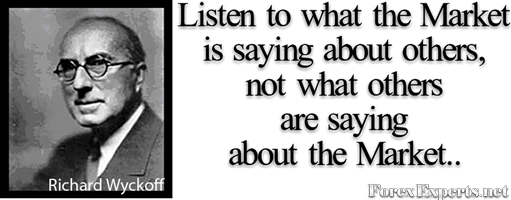 Adjusting Richard Wyckoff Volume Spread Analysis to Trade the Forex Market
Adjusting Richard Wyckoff Volume Spread Analysis to Trade the Forex Market
“Those who think they are studying the market, what all they are doing is studying what someone else has said.. and not what the market has said about itself”
Richard D Wyckoff (1873-1934) method was introduced via a popular newsletter he used to send to 200,000 subscribers in the 1920's 'The Magazine of Wall Street'. Richard Wyckoff's method is focused on:
-
measuring accumulation/distribution
-
defining price and volume correlation
Wyckoff believed that measuring supply and demand through price and volume is the key to predicting the future market movements. Wyckoff also argued that no trade position should be opened unless there is a predetermined exit strategy. The Richard Wyckoff method was originally introduced as a tool for analyzing and forecasting the stock market, but in this analysis, we are going to apply Wyckoff's wisdom on the Foreign Exchange trading.
The Three Laws of Richard Wyckoff
According to Wyckoff, global financial markets operate under three laws.
(1) The Law of Supply and Demand
When demand is greater than supply the market sooner or later will go up, and when supply is greater than demand the market will eventually fall. Price and volume are used in order to measure the strength of these two economic forces. Measuring the volume when trading stocks is an easy process, but the Forex Market is an OTC market and measuring directly volume is a little bit tricky. Hence, Forex traders can use other data sources, for example, the aggregate number of positions in the Forex Futures market.
(2) The Law of Cause and Effect
In order to have an effect (price movement), you need a cause. The effect will be in proportion to the cause. Moreover, the most profitable price movements (effect) occur when the price has already gone through a period of accumulation or distribution. The occurrence of an accumulation/distribution period after a strong price movement is a very common phenomenon when trading currencies.
(3) The Law of Effort vs Results
If there is an effort (cause), the result (effect) must be in equal proportion to that effort. If there are any disharmonies between price and volume that can be seen as a sign of an upcoming change. Probably signifies a change in the trend direction. For identifying effort and evaluating accumulation vs distribution, the on-balanced-volume index was used. This index was called “Optimism vs. Pessimism”.
Richard Wyckoff's Five Steps
These are the five steps for evaluating every trade according to Richard Wyckoff:
(1) Determine the current trend and the current position of the market
Is the market ranging or trending? Is there any indications of an upcoming new trend formation? You can answer these questions by using historical support and resistance levels, price patterns, candlestick formations, breakouts, etc.
(2) Follow the trend by determining relative strengths or weaknesses
Once you determine the master trend of the market (step-1) you need to trade in the same direction by evaluating the relative strengths or weaknesses. For example, if the US Dollar market, as expressed by the USDX index, is moving on a downtrend, trade only by going short on US Dollar. That means practically going long on EURUSD, going long on GBPUSD, going short on USDCHF, etc. Always open positions that are in harmony with the master trend of the market you are trading.
(3) Select trades with a cause significant enough to produce a satisfactory effect (profit)
When you trade the financial markets you are exposed to what is called as the market risk but also to the cost of your transactions. Therefore, you must choose only causes (potential trades) that will likely produce payouts (effect) strong enough to cover both your risk and the transaction cost. That means practically select only trades with a minimum Reward/Risk ratio of 2, preferably 3 or more.
According to Wyckoff, in order to produce a significant cause, choose to trade only markets that are already under accumulation / re-accumulation. As it was mentioned earlier a significant cause requires a period of accumulation in order to have a strong effect.
(4) Evaluate the readiness of an asset to respond immediately to its cause
Anyone who has traded Forex or any other financial market can understand the importance of the right timing. An undervalued asset can remain undervalued for long periods of time that may last even for many months. Hence, time itself forms a controversial type of risk.
Significant shifts in demand or supply can signify the readiness of a market to enter a strong trend. As the Forex market doesn't offer reliable volume data you can identify demand/supply shifts by evaluating changes in price volatility, changes in market sentiment, or by evaluating data deriving from the futures and options markets (COT analysis, etc.).
In addition, chart patterns and several indicators can signify the readiness of an asset to enter a strong trend. For example, by using the MACD histogram in H1, H4, and D1 timeframes and by seeking price breakouts or divergences between the price and the MACD histogram.
(5) Time your trades to anticipate movements
The timing of trades can be done by using the three marker laws described earlier (Demand & Supply, Cause & Effect, Effort & Results).
The phases of the market according to Wyckoff are illustrated in the below S&P500 chart (by readtheticker.com).
Chart: Wyckoff Logic on S&P500

Conclusions When Using the Wyckoff Method
According to Wyckoff, the best strategy is to choose a strong market and within this market to choose the strongest asset. Traders should select only causes (trades) offering a strong effect (payout) and they must be very careful to time the market right. Wyckoff method focuses on several issues but majorly on-trend evaluation and market phases identification. Wyckoff argued that a strong price movement occurs usually after the price has absorbed the current price levels (accumulation/distribution phase). Traders should avoid entering positions before the accumulation/distribution phase is completed unless they really know what they are doing. It is wiser to wait for a clear change in demand/supply capable of producing a significant price movement. This change in demand/supply can be identified by using several tools and indicators based on price volatility and volume.
COMPARE BROKERS: » DIRECTORY | » TRADE SPREADS | » FOREX SCALPING | » SWAP RATES | » FUNDS SAFETY
■ Adjusting Richard Wyckoff Volume Spread Analysis System to Trade the Forex Market
G.P.
ForexExperts.net











